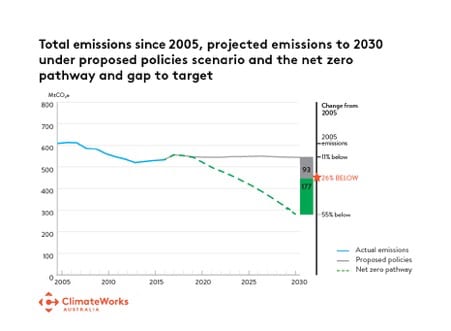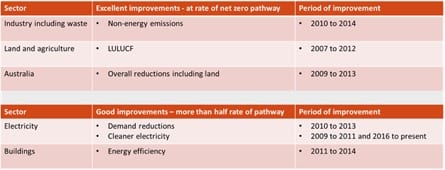Australia could cut electricity emissions by 68 per cent by 2030
Author: Renew Economy Date Posted:9 September 2018

Australia’s new prime minister Scott Morrison confirmed last week that the federal government would not be walking away from its Paris Agreement on climate change to reduce emissions by 26-28 per cent below 2005 levels by 2030.
While this is welcome news, the dumping of the emissions reduction component from the government’s signatory energy policy, the National Energy Guarantee (NEG) has left many wondering how the government will actually reach its Paris targets.
Of course, the NEG was never designed to act as a national emissions policy but rather a mechanism to cut emissions from the electricity sector by 26 per cent by 2030.
Presuming the NEG would achieve its target, Australia would still be well short of meeting our Paris targets which requires an emissions reduction of 26 per cent by 2030 across the whole of economy, not just in one sector – albeit an important one.
So where is Australia actually at regarding reducing emissions?
A new report by ClimateWorks Australia has found that Australia is not yet on track to meet its commitments under the Paris Agreement but has sufficient potential to do so given the right circumstances.
The Tracking Progress to Net Zero Emissions report shows the net zero emission reduction pathways required for each sector in the economy, rates performance by sector from 2005 and illustrates the likely emissions in 2030 under currently proposed policy settings.
It found Australia needs to double emissions reduction progress to achieve the federal government’s target of 26-28 per cent by 2030 and triple progress to be on a pathway to reach net zero emissions by 2050.
The good news is that these improvements in emissions are achievable. Our analysis shows emissions could be reduced to 55 per cent below 2005 levels by 2030, while maintaining economic growth.
This would put Australia on track to net zero emissions by 2050 and fully meet our Paris commitments. A scenario that achieves this would need approximately 70 per cent renewable generation in the electricity grid by 2030.
Our analysis uses federal government carbon and energy statistics and draws on ClimateWorks’ earlier research, the Pathways to Deep Decarbonisation in 2050 undertaken in partnership with Australian National University.
Projected emissions reduction progress to 2030
Looking out to 2030, our analysis projected the likely emission reductions due to existing and proposed policies.
These include the NEG, current proposals for updates to the Building Code in 2019 and the least stringent target from current proposals for vehicle fuel efficiency standards. The National Energy Productivity Plan primary energy target would be met under this scenario.
Assuming that these policies are implemented in their currently proposed form, national emissions are expected to reduce to around 11 per cent below 2005 levels in 2030 – that is no change from where they were last year.
The abatement potential if these policies are ‘enhanced’ from their current proposed form has also been modelled. If state renewable energy targets for Victoria and Queensland are additional to the NEG and the most stringent target for vehicle fuel efficiency standards are adopted, national emissions could fall to 14 per cent below 2005 levels in 2030 – a 3 per cent improvement from the proposed policies scenario.
In the electricity sector, our analysisidentified a further 78 MtCO2e of abatement potential could be unlocked using currently available renewable energy technologies and improvements to fossil fuel generation. And given how quickly technology costs are falling there is likely to be further potential available.
Demand side improvements (such as energy efficiency in electric end-uses) could unlock a further 16 MtCO2e. If Australia unlocks all this available potential, emissions in the electricity sector could be 68 per cent below 2005 levels by 2030.
Australia has been on track before
Our analysis found there were times in recent history where emissions reductions were on track to meet the net zero pathway. As Figure 2 shows, overall emission reductions in Australia were on track to reaching net zero emissions by 2050 between 2009 and 2013. This occured while the economy grew at an average of 3 per cent per year.

Australia has many options for achieving its Paris targets
Tracking Progressshows existing and proposed policies will not improve emissions reductions beyond levels in 2017. Clearly there is a need for new and expanded policies to tap into more of the emissions reduction potential available across the Australian economy.
Our analysis shows the greatest potential for further emissions reductions are in the electricity and land sectors, and then industry, transport and buildings.
For example, emissions in the electricity sector are projected to be 21 per cent below 2005 levels by 2030 under proposed policies (including the NEG with a target of 26 per cent for the National Energy Market). If state renewable energy policies additional to the NEG, electricity sector emissions would fall to 29 per cent below 2005 levels by 2030.
If all the potential for electricity emissions reduction identified on the net zero pathway were achieved the sector could cut emissions by 68 per cent by 2030.
Land sector emissions are currently 64 per cent below 2005 levels but are projected to rise by more than all the projected emissions savings from cleaner electricity, to 45 per cent below 2005 levels, on current and proposed policies. (Agriculture emissions are expected to grow more than planting and revegetation.)
There is a large amount of further potential – enough to fully offset all land sector emissions and reach 103 per cent below 2005 levels.
In contrast, the transport sector is projected to increase emissions to 29 per cent above 2005 levels by 2030 on proposed policies – or 38 per cent above if the NEG emissions target and vehicle emissions standards are not approved.
On these settings, improvements to the energy efficiency of some vehicles does not outweigh increased activity across all vehicles. Further potential using proven cost effective technology is available which would reverse the sector’s rising emissions and reduce emissions to 4 per cent below 2005 levels.
The Australian Government has committed itself to develop a long term emissions reduction strategy in 2020. In addition, each of the state governments in the National Electricity Market have a goal to reach net zero emissions before 2050 and are in various stages of implementation planning.
Without further policies, Australia will not be on track for the net zero pathway or the government’s 2030 target. Now is the time to develop plans and policies to support all sectors to reach their emissions reduction potential.
Authors: Anna Skarbek, ClimateWorks Australia CEO; Anna Malos, ClimateWorks Australia policy manager and Ben Meyer, ClimateWorks Australia business analyst
https://reneweconomy.com.au/australia-could-cut-electricity-emissions-by-68-per-cent-by-2030-2030/Read Article



